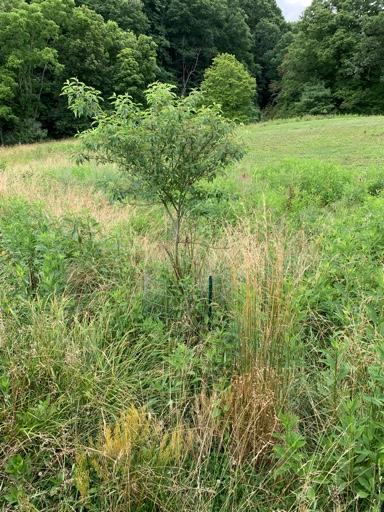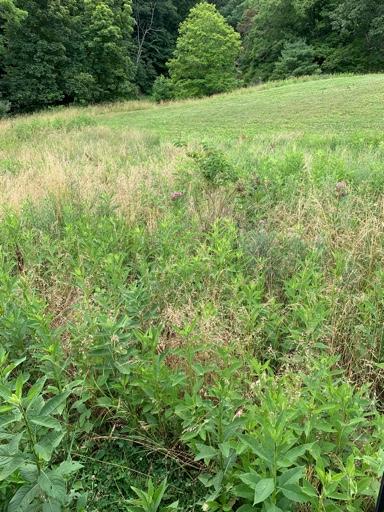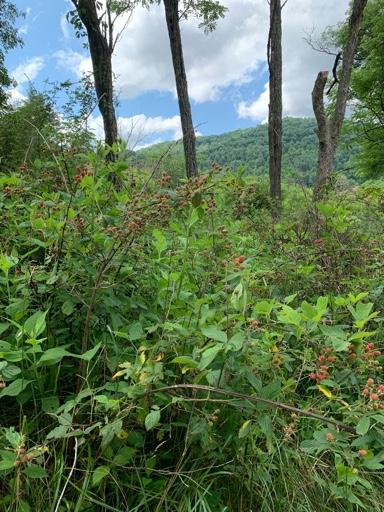-
The forum has been upgraded to support both light and dark themes. Click here for directions.
You are using an out of date browser. It may not display this or other websites correctly.
You should upgrade or use an alternative browser.
You should upgrade or use an alternative browser.
Fired the Tube and Hired the Cage
- Thread starter dogghr
- Start date
Tubes are good for hardwoods, BUT they need to be 5'+. 4' dont stop browsing. Being cheap, we found lots of them on CL from old CREP plantings. We found mesh protectors work well to extend the height with a zip tie. You can find the mesh protectors cheap at Forestry Suppliers, etc. Amazon has a million kinds of zip ties. The removable/reversible ones are nice.
1/2" PVC conduit makes a great stake. Buy 10' lengths and cut in half.
https://www.forestry-suppliers.com/product_pages/products.php?mi=16201&itemnum=17040
1/2" PVC conduit makes a great stake. Buy 10' lengths and cut in half.
https://www.forestry-suppliers.com/product_pages/products.php?mi=16201&itemnum=17040
Last edited:
Keith Nehrke
Member
The benefits of 20/20 hindsight and learning the hard way. I had a roll-off dumped at the property this spring and removed all tubes less than 5' high. A member of another forum came over and grabbed a couple hundred, but most of them were simply tossed (they were on their second life already and didn't owe anybody anything). We threw out thousands. And good riddance.
Lo and behold, most of the shrubs are now higher than they've been in five years. The deer were using the tubes as cues to find fresh growth.
A buddy of mine recommended using couple rows of 40 lb fishing line between stakes to create small enclosures, and that works great. We got a bunch of Copper Chinquapin out of browse height in two years. And I stuck with 5' tubes, since most of the trees are already out of them, but they are slowly being removed as well - unfortunately, the mortality rate was stupid given rodents, wasps, and ants - and the trees themselves are spindly. Never a tube, never again.
Lo and behold, most of the shrubs are now higher than they've been in five years. The deer were using the tubes as cues to find fresh growth.
A buddy of mine recommended using couple rows of 40 lb fishing line between stakes to create small enclosures, and that works great. We got a bunch of Copper Chinquapin out of browse height in two years. And I stuck with 5' tubes, since most of the trees are already out of them, but they are slowly being removed as well - unfortunately, the mortality rate was stupid given rodents, wasps, and ants - and the trees themselves are spindly. Never a tube, never again.
dogghr
Well-Known Member
To keep deer from browse tubes would have to be no less than 6 feet and probably 7. Even with the cages deer still manage to browse some. Except for apple trees which I've never tubed, the Silkies and Hazelnuts are bush type trees. I should've never tubed them. I showed the poorest caged trees, the others are much larger since removing the tubes than these. What I do like about tubes if anything, is you easily know where trees are planted especially when done in managed fallow fields that are thick with growth.
And in fairness, may depend on how one manages. I'm the type I plant and walk away. You can see I don't mulch, seldom spray for weeds and grasses around the trees, etc. Nature doesn't do that, why should I? If a tree lives, so be it, if it doesn't , then it doesn't deserver to coexist with me. Im not babying them or anything else on the farm.
And in fairness, may depend on how one manages. I'm the type I plant and walk away. You can see I don't mulch, seldom spray for weeds and grasses around the trees, etc. Nature doesn't do that, why should I? If a tree lives, so be it, if it doesn't , then it doesn't deserver to coexist with me. Im not babying them or anything else on the farm.
Keith Nehrke
Member
I think it depends how many tress youre planting affects tube/cage selection. If you're planting 10 trees, cages win easily, but if you're planting 100 trees, tubes are more practical.
I agree 100%, but if only three out of those one hundred survive, then I've spend a bunch of time and $ thinking that I'm growing trees when in fact I'm growing fodder for mice. Overall, my experience has been that caged trees survive at nearly 100%, when they're planted correctly. It's more work at the start, and without knowing outcomes it sure feels harder to justify. But man do I wish that I'd done it differently.
Of course, that's my property, right across the street from a suburban park and thick as a jungle. it could be very different somewhere else. Interestingly though, the choke cherry in my backyard that's in a cage is doing stellar, but the one in a tube is spindly and bending horribly because it is top heavy above the tube. That's my "controlled" experiment, with an n of one.
dogghr
Well-Known Member
Another couple trees freed from the tubes same time as above post. More ground moisture here and better response. My pear trees on a dry ridge have grown 8 ft in a couple years in cages. These Silkies would’ve surpassed that by far if only …

Also notice Milkweed which is prevalent in my fallow managed fields. Great stuff for Monarch butterflies and bees.
On another site posters go crazy wanting milkweed seed for hunting wind direction. They even buy the floater seeds. I have it by the truckload.

Sent from my iPhone using Tapatalk

Also notice Milkweed which is prevalent in my fallow managed fields. Great stuff for Monarch butterflies and bees.
On another site posters go crazy wanting milkweed seed for hunting wind direction. They even buy the floater seeds. I have it by the truckload.

Sent from my iPhone using Tapatalk
We've gotten pretty proficient getting hardwood bare root seedlings going in tubes. KBC (dibble) bar, tube and 1/2" conduit. We're probably in the 80% range for leaf out when planted in spring, and maybe 60% survive over the first winter.I agree 100%, but if only three out of those one hundred survive, then I've spend a bunch of time and $ thinking that I'm growing trees when in fact I'm growing fodder for mice. Overall, my experience has been that caged trees survive at nearly 100%, when they're planted correctly. It's more work at the start, and without knowing outcomes it sure feels harder to justify. But man do I wish that I'd done it differently.
Of course, that's my property, right across the street from a suburban park and thick as a jungle. it could be very different somewhere else. Interestingly though, the choke cherry in my backyard that's in a cage is doing stellar, but the one in a tube is spindly and bending horribly because it is top heavy above the tube. That's my "controlled" experiment, with an n of one.
Native Hunter
Well-Known Member
Tree tubes in east texas are:
microwave ovens in summer,fireant condos,field mice cover,wasp nest magnets,raccoon attraction(in search of wasps),fungus breeding ground,weed tubes, and small bird traps/graveyards
aside from above, a great product........
bill
Don’t be so shy Bill. Tell us what you really think of tubes
T-Max
Well-Known Member
I have actually lost a few caged trees which were previously tubed due to not being supported well enough. They got "leggy" in the tubes and the wind caused them to rub the cages which ate through the bark. Have to stake them for a little while until they get some strength.
Tubes for a year maybe two, then cut off and cage. I’ve got 4000 trees that like this approach.
Sent from my iPhone using Deer Hunter Forum
Sent from my iPhone using Deer Hunter Forum
Native Hunter
Well-Known Member
So I guess the general consensus agrees that tubes are bad!!!
No, tubes and cages are equal, and all blackberries are equal too.

Native Hunter
Well-Known Member
We picked wild ones this morning. You will also note that I have a few blueberries off to the side. I've discovered that I can grow blueberries at the farm without caging them. My deer don't browse blueberry plants.


snowracerh
Active Member
Cut down a tree, plant in the tops...the only option... I've used tubes and cages...to my cages were great for 10-20 for apple trees, not to start a forest
Sent from my SM-G986U using Tapatalk
Sent from my SM-G986U using Tapatalk
dogghr
Well-Known Member
These Hazelnuts planted 2013 never reached the top of the tubes. No chance for browsing. But plenty of. wasps, birds, and weeds.
They were released from their prison last summer. I thot they were just slow growing. Wrong.
Take note of fallow field food plot. Pigweed for deer, bear , and bird. Milkweed for Monarchs. More Ragweed than deer can browse among other Native grasses.
But back to tubes……Tubes have their place. For me it’s piled up over the hill.

Sent from my iPhone using Tapatalk
They were released from their prison last summer. I thot they were just slow growing. Wrong.
Take note of fallow field food plot. Pigweed for deer, bear , and bird. Milkweed for Monarchs. More Ragweed than deer can browse among other Native grasses.
But back to tubes……Tubes have their place. For me it’s piled up over the hill.

Sent from my iPhone using Tapatalk

